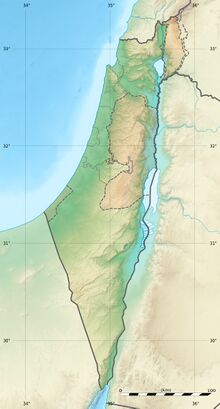حصار القدس (587 ق.م.)
| ||||||||||||||||||||||||||||||||
في 601 ق.م.، السنة الرابعة من حكم نبوخذنصر الثاني ملك بابل حاول احتلال مصر وفشل وتكبد خسائر جسيمة مما أدى لثورة عدة دول في بلاد الشام كانت خاضعة له منها مملكة يهودا التي توقف ملكها يهوياقيم عن دفع الجزية لنبوخذنصر. حسب سجل الأخبار البابلية حاصر نبوخذنصر القدس وسقطت في 2 مارس 587 ق.م..
أخرج نبوخذنصر ممتلكات القدس وجميع خزائن الهيكل ونفى الملك الجديد وحاشيته والأعيان مع قسم كبير من سكان المملكة يصل عددهم عشرة آلاف إلى بابل منهم حزقيال ودانيال. حسب الكتاب المقدس لم يبق أحد إلا فقراء الأرض. هذا السبي البابلي موصوف في العهد القديم
. . . . . . . . . . . . . . . . . . . . . . . . . . . . . . . . . . . . . . . . . . . . . . . . . . . . . . . . . . . . . . . . . . . . . . . . . . . . . . . . . . . . . . . . . . . . . . . . . . . . . . . . . . . . . . . . . . . . . . . . . . . . . . . . . . . . . . . . . . . . . . . . . . . . . . . . . . . . . . . . . . . . . . . .
التأريخ
Babylonian Chronicles, which were published by Donald Wiseman in 1956, establish that Nebuchadnezzar captured Jerusalem the first time on March 16, 597 BC.[1] Before Wiseman's publication, E. R. Thiele had determined from the biblical texts that Nebuchadnezzar's initial capture of Jerusalem occurred in the spring of 597 BC,[2] but other scholars, including William F. Albright, more frequently dated the event to 598 BC.[3]
الحصار
To avoid the destruction of Jerusalem, King Jehoiakim of Judah, in his third year, changed his allegiance from Egypt to Babylon. He paid tribute from the treasury in Jerusalem, and Nebuchadnezzar took some temple artifacts and some of the royal family and nobility as hostages.[4] In 601 BC, during the fourth year of his reign, Nebuchadnezzar unsuccessfully attempted to invade Egypt and was repulsed with heavy losses. The failure led to numerous rebellions among the states of the Levant which owed allegiance to Babylon, including Judah, where King Jehoiakim stopped paying tribute to Nebuchadnezzar[5] and took a pro-Egyptian position.
Nebuchadnezzar soon dealt with these rebellions. According to the Nebuchadnezzar Chronicle,[6] he laid siege to Jerusalem, which eventually fell in 597 BC. The Chronicle states:
In the seventh year [of Nebuchadnezzar, 598 BC] in the month Chislev [November/December] the king of Babylon assembled his army, and after he had invaded the land of Hatti (Syria/Palestine) he laid siege to the city of Judah. On the second day of the month of Adar [16 March] he conquered the city and took the king [Jeconiah] prisoner. He installed in his place a king [Zedekiah] of his own choice, and after he had received rich tribute, he sent forth to Babylon.[7]
Jehoiakim died during the siege, possibly on December 10, 598 BC,[8] or during the months of Kislev,[9] or Tevet.[10] Nebuchadnezzar pillaged the city and its Temple, and the new king Jeconiah, who was either 8 or 18, and his court and other prominent citizens and craftsmen, were deported to Babylon.[11] The deportation occurred prior to Nisan of 597 BC, and dates in the Book of Ezekiel are counted from that event.[12]
Nebuchadnezzar installed Jeconiah's uncle, Zedekiah as puppet-king of Judah, and Jeconiah was compelled to remain in Babylon.[13] The start of Zedekiah's reign has been variously dated within a few weeks before,[14] or after [15][16] the start of Nisan 597 BC.
The Book of Kings (written in the 7th and 6th centuries BC) records that 10,000 people were exiled during this time,[17] also adding 7,000 craftsmen and 1,000 "smiths",[18] bringing the total to 18,000.[19] Comparatively, the Book of Jeremiah mentions 3,023 people taken into captivity.[20] Some scholars have argued whether this number includes only men. If this is true, perhaps as many as 15,000 to 30,000 Judeans were exiled.[19]
المصادر
- ^ D. J. Wiseman, Chronicles of Chaldean Kings in the British Museum (London: Trustees of the British Museum, 1956) 73.
- ^ Edwin Thiele, The Mysterious Numbers of the Hebrew Kings, (1st ed.; New York: Macmillan, 1951; 2d ed.; Grand Rapids: Eerdmans, 1965; 3rd ed.; Grand Rapids: Zondervan/Kregel, 1983). ISBN 0-8254-3825-X, 9780825438257, 217.
- ^ Kenneth Strand, "Thiele's Biblical Chronology As a Corrective for Extrabiblical Dates," Andrews University Seminary Studies 34 (1996) 310, 317.
- ^ C. Hassell Bullock (May 2007). An Introduction to the Old Testament Prophetic Books. p. 340. ISBN 9781575674360.
- ^ The Divided Monarchy c. 931–586 BC
- ^ Geoffrey Wigoder, The Illustrated Dictionary & Concordance of the Bible Pub. by Sterling Publishing Company, Inc. (2006)
- ^ No 24 WA21946, The Babylonian Chronicles, The British Museum
- ^ Horn, Siegfried H. (1967). "The Babylonian Chronicle and the Ancient Calendar of the Kingdom of Judah" (PDF). Andrews University Seminary Studies. V (1): 21.
- ^ Lipschits, Oded (2002). "'Jehoiakim Slept with his Fathers...' (II Kings 24:6) – Did He?". Journal of Hebrew Scriptures. 4: 23. doi:10.5508/jhs.2002.v4.a1. ISSN 1203-1542.
{{cite journal}}: Check|author-link=value (help) - ^ Green, Alberto R. (1982). "The fate of Jehoiakim". Andrews University Seminary Studies. 20 (2): 106. Archived from the original (pdf) on 2016-03-04. Retrieved 2014-12-17.
- ^ The Oxford History of the Biblical World, ed. by Michael D Coogan. Published by Oxford University Press, 1999. pg 350
- ^ Young, Rodger C. (March 2004). "When Did Jerusalem Fall?" (PDF). Journal of the Evangelical Theological Society. 47 (1): 32ff.
- ^ Britannica.com, Zedekiah
- ^ Thompson, John Arthur (1980). The Book of Jeremiah. Wm. B. Eerdmans Publishing. p. 729.
- ^ Hayes, John H.; Hooker, Paul K. (2007). A New Chronology for the Kings of Israel and Judah and Its Implications for Biblical History and Literature. Wipf and Stock Publishers. p. 95.
- ^ Thiele, Edwin R. (1970). The Mysterious Numbers of the Hebrew Kings. Kregel Academic. p. 192.
- ^ Kings%2024:14&verse={{{3}}}&src=! 2 Kings 24:14 {{{3}}}
- ^ Kings%2024:16&verse={{{3}}}&src=! 2 Kings 24:16 {{{3}}}
- ^ أ ب Smith-Christopher, D. L. (1997-01-01), Reassessing the Historical and Sociological Impact of the Babylonian Exile, BRILL, pp. 7–21, doi:, http://dx.doi.org/10.1163/9789004497719_008, retrieved on 2022-05-24
- ^ Jeremiah 52:28 {{{3}}}


